|
Back to Part One: Firenze
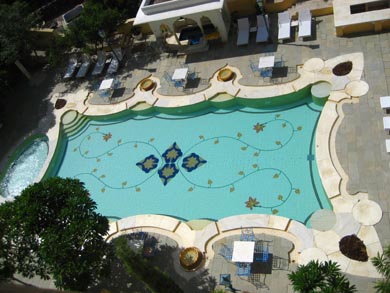
Above Samode Palace’s swimming
pool.
WHEN YOU SLEEP a night at Samode
Palace you dream of history. The 400-year old structure is still
much as the rulers might have known it centuries ago: 43 opulent
suites facing classical courtyards, maintained in the retro style
of the maharajahs. Wide, low couches and soft four-poster beds,
and déco-inspired marble baths speak unabashed luxury. Chittering
birds dart past your balcony, and jacarandas surrounding the ornate
pool below color the landscape with their eerie blue-purple blossoms.
Don’t leave anything out on your terrace: the monkeys will
get it, and though that’s part of the experience, never engage
them: they’re notoriously ruthless.
You reach the palace, only one hour by car from
Jaipur, via a twisting road, which takes you through an ancient
village nestled in a canyon below an old fort. Proceed through an
overgrown banyan gateway and you’ve left modernity behind,
immersed in vaulted chambers decorated with vast murals and filigree,
hallways covered in thousands of tiny mirrors, endless hand-made
details rarely seen in our era. The voice of a live singer echoes
through the cavernous courtyards, and you may even catch a traditional
puppet show in progress.
Guests on the Rajasthan circuit typically stay
an average of two nights; meanwhile, the property caters to weddings,
events and conferences. You can avail yourself of traditional fare
in the revival style dining room (try the Indian BBQ
and a tasty dessert called Malpua), but a more romantic option would
be a private dinner overlooking the infinity pool and its traditional
dome.
Samode Palace’s compact gift shop down by
reception turns out to be a super find. Shopping India can be a
stressful experience, but here you’ll discover taseful art
objects, camel bone boxes, traditional jewellery and pashminas from
Kashmir at competitive prices, a great convenience.
A two-to-one staff-to-guest ratio insures the
expected level of service. Subtle details like the Maharajah’s
crest on all the restaurant china add to this memorable journey
into the elegant past.
Samode Bagh, one of two sister properties, is
a family resort with rustic tents and stables set in a massive walled
garden, about 20 minutes down the road. And Samode Haveli, an opulent
palace in Jaipur from the same management, looks to be another interesting
lodging choice.
Samode Palace
Rajasthan
India
www.samode.com
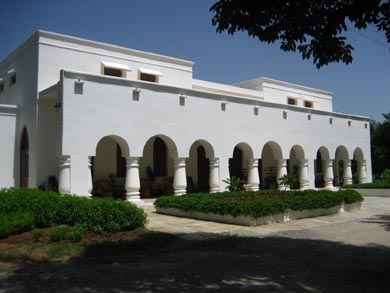
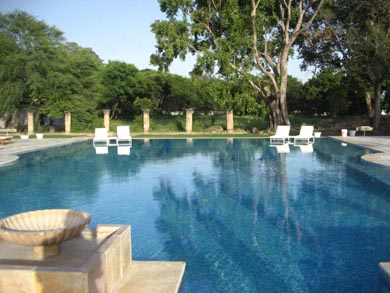
Top Shahpura Bagh’s guest-house
entry. Above The Infinity pool, opened last year.
SHAHPURA BAGH
IS your chance to experience first-hand a 30-acre heritage
estate, the summer residence of the rulers of Shahpura since 1630.
This oasis, surrounded by dry lakes, has abundant wildlife watching,
with six spacious luxury suites and four deluxe rooms crafted in
a restored déco-style country guest house. (Dry lakes usually
fill up abundantly during the monsoons, as they were built as water
harvesting sites. Rajasthan has been facing water scarcity for the
last few years and hence the sad state of lakes in these parts.)
The airy lodgings feature vintage furnishings,
vaulted ceilings, vast tiled baths, and a central corridor opening
out to a beautiful new infinity pool, perfect for cutting the heat
of the day.
Words like history, family, and generations
come to mind. This intimate view of life in a family house helps
you gain a sense of the values held dear: stewardship, conservation
and sustainability. It’s a hybrid kind of vacation, dining
with the family, sipping scotch with the patriarch in the salon
before dinner, meeting the matriarch early in the morning in the
sunlit breakfast porch. The food served is fresh, rich, hearty,
spicy and traditional. All the milk, yogurt, cheese and eggs come
from the property’s dairy.
Real sustainable tourism like this affords extraordinary
experiences rich in memorable details. You can take an open jeep
into the local village, where your host Sat Singh, a National
Geographic photographer in his professional life, points out
family tombs or shows you a local health clinic, or walks you into
the courtyard where a traditional potter is at work making clay
water vessels on a wheel in the same manner as his ancestors, or
stops on a country road to give some men returning from the fields
a ride home. You can visit a deserted fort at dusk, and, from the
parapets, watch bats swarm into the night sky from the cistern where
thousands live—the sight of a lone fruit bat swooping by, its
wingspan as broad as that of a barn owl or a hawk an unforgettable
moment. And little reminders like a stack of paper bags made in
local cottages from recycled Hindi newspapers add to the mix.
The unexpected and unconventional amenities and
snapshots make Shapura Bagh a welcome stopover on your Rajasthan
odyssey.
Shahpura Bagh
Darbar Ki Kothi
Shahpura
District Bhilwara
Rajasthan 311404
India
Telephone +91 982 812-2012 and 812-2013
www.shahpurabagh.com
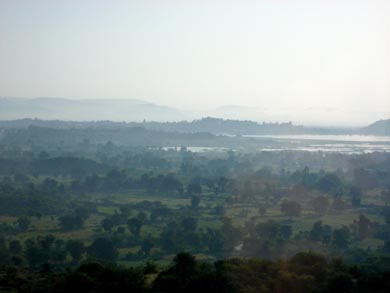
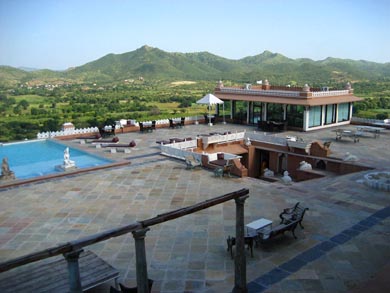
Top View of the dawn over Udaipur. Above Fateh Gahr’s
pool, restaurant terrace and Aravali Hills.
FOR AN INTERESTING RETREAT at the
end of a trip around the golden triangle, Udaipur’s chakra-wise
Fateh Gahr is a youthful, fun option for a stopover in the city
of the famous Lake Palace.
Open only a year and a half, the newly-constructed
hilltop citadel of 51 rooms was built under a special government
designation called a ‘heritage renaissance structure’.
This means that much of the décor has been repurposed from
the ruins of an old palace 150 km away, and shaped into an open,
spacious, terraced, wind-blown property. There are exceptional views
of Lake Pichola, an especially attractive and convenient location
away from the overload of the city.
While the property has convenient elevator access,
much of the experience consists of transiting a lot of marble steps
connecting broad verandas. Through casual wandering you come upon
a succession of old archways, columns and statuary, window and door
details. In the lobby you can catch displays of ceremonial family
armaments, exotic examples of superior craft.
Eco-savvy, the property takes advantage of solar
panels and small windmills for a share of its power needs. It’s
a perfect scale for groups of eight to ten.
Highly recommended is room 47, with its corner
exposure, terrace and view of the Monsoon Palace on a presiding
hilltop. The lower level features terrace suites with private plunge
pools. This property offers comfort, convenience, good value in
a casual, informal atmosphere, an optimistic harbinger of the new
India.
Fateh Garh
Sisarma, Udaipur
Rajasthan
India
Telephone 91 99286 66-009
www.fatehgarh.in
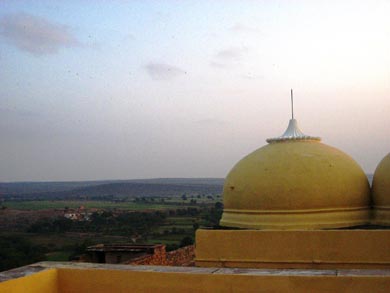
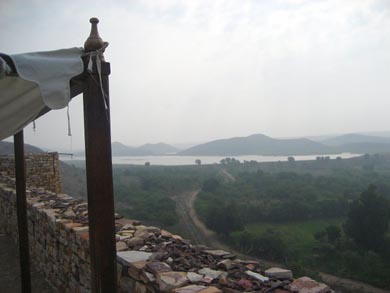
Top Dusk in Rajasthan, viewed from
the rooftop of Ramathra Fort. Above View from the ramparts,
showing platform bed at left, water cachement in distance.
ECO-TOURISTS
AND BIRD-WATCHERS ARE a committed
lot, and the resorts who cater to them need to be appropriately
committed, well-situated, and offer authentic activities. Ramathra
Fort, a six-suite and six-tent renovated fort in rural Rajasthan
functions as a tourist hotel close to nature, yet featuring all
the modern luxuries.
A five-year renovation and restoration
by descendants of the founder has given new life to their seventeenth-century
ancestral home, which now hosts guests from all over the world.
Ramathra Fort’s suites are furnished in a rustic style, they
are spacious, austere and comfortable, made all the more luxurious
by private open-air terraces with outdoor bathtub and opulent shower.
The fort casts a distinctive silhouette against the Arawali Hills,
its perimeter wall crowned with parapets and wide ramparts, a fantasy
from the princely past.
This is an ideal stopover for those in transit
through Rajasthan, close to Sawai Madhupur and the Ranthambhore
tiger zone, situated in the interior, undisturbed by urban intrusions.
The government expanded the vast, protected zone in 2009, so that
Ramathra Fort now sits at the edge of its new perimeter.
Until recently, tigers roamed the area, as well
as bandits. While the dacoits have long disappeared, increasing
numbers of wildlife appear each year. Naturalists and birders delight
at the 67 species of birds sighted.
In an environment of no pollution and no noise,
there’s no such thing as rushed itineraries. An almost-deserted
village sits a short walk away, surrounded by irrigated fields.
You may well catch a ceremony at a local temple just down the hill.
There, festivals and rituals connected to specific deities occur.
It’s an opportunity to experience living heritage, where ancient
traditions still exist.
Another way the fort retains the character of
the original lifestyle is through authentic homestyle cuisine. Everything
served is sourced fresh, nothing frozen. Seasonal vegetables come
only from local villages, with produce free of chemical fertilizers.
The cook, who comes from one such village, does a superior job of
presenting the finest rich flavours of the regional cuisine, perhaps
the best food tasted in a circuit of properties in Rajasthan.
Ramathra Fort is well suited as a retreat, as
the site for a small reunion, art safaris, or simply a getaway to
the back country. Minimum stay two nights, tariff all-inclusive
except for wilderness drives, and family-friendly. Bear in mind
there are no tents March to October, and no wifi until 2011, though
your G3 mobile phone works perfectly. Appropriately for the spirit
of the place, there are no televisions to be found. The profound
silence which envelopes the fort at night guarantees an outstanding
sleep in the ultra-comfortable bed.
Ramathra Fort will add two more suites in 2011,
keeping the size of the property at a sweet and managable scale
for a truly personal stay.
Ramathra Fort
PO Sapotra, District Karauli
Rajasthan
India
+91 9829013475
www.ramathrafort.com
Part Three: Paris
|  |
| Lucire’s luxury travel special
|
CONNECTIONS IN INDIA
ARE—to be brutally candid—difficult at best. Even
the most seasoned traveller needs the help of a professional planner
to get from point-to-point with the minimum of hassle. You might
encounter sluggish trains, washed-out roads, or culture shock in
the lawless badlands of the Haryana–Uttar Pradesh border, cancelled
or overbooked flights, weird way stations with characters out of
a Hindu David Lynch movie. Anything can happen, or nothing, but
it is better to be insulated from the start.
Lucire highly recommends Travelscope
India, who successfully move voyagers, experienced and novice,
to the farthest ends of the subcontinent, drawing on their own carefully
built network of lodgings and conveyances—private cars to chartered
jets, remote properties to luxury beyond imagination. If you go,
don’t puzzle it out yourself, please. India’s big cities
are booming, but beyond the metropolis you still need to seek the
help of insiders. It will make all the difference.
Travelscope India
www.travelscopeindia.com
Mohan Narayanaswamy, Managing Director: mohan @ @ travelscopeindia.com travelscopeindia.com
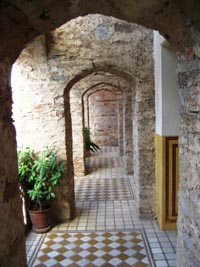
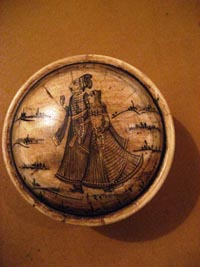
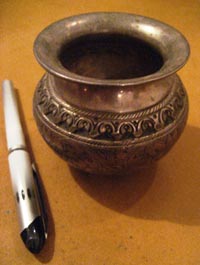

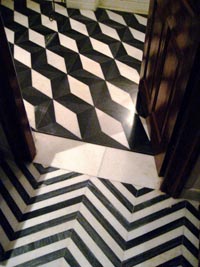
From top The passage off Samode Palace’s reception area.
Camel bone box in the gift shop. A small hammered metal vessel in
the gift shop. The Maharajah’s monogramme on the dishes. The
inlay marble pattern on the bathroom floor.
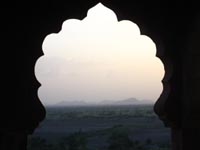
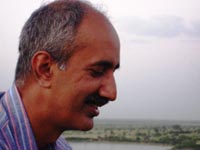
Top Dusk over Rajasthan, from Shahpura Fort. Above
Sat Singh, General Manager and National Geographic photographer.
Below A rescued doorway at Fateh Gahr. Bottom
Classical statuary in the alcove at Fateh Gahr.
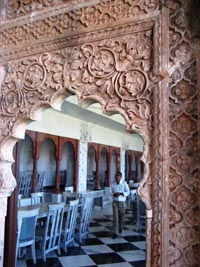
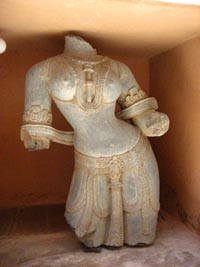
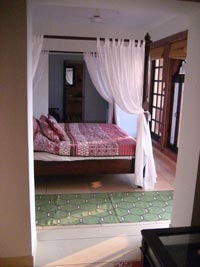
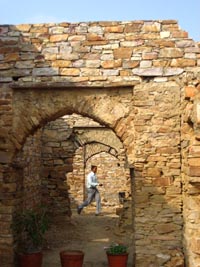
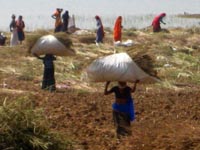
Above, from top Light-filled bedroom
in the suite at Ramathra Fort. A restored colonnade. Rajasthani
women gather reeds on the lakeshore.
Stanley Moss is travel editor of Lucire.
|

